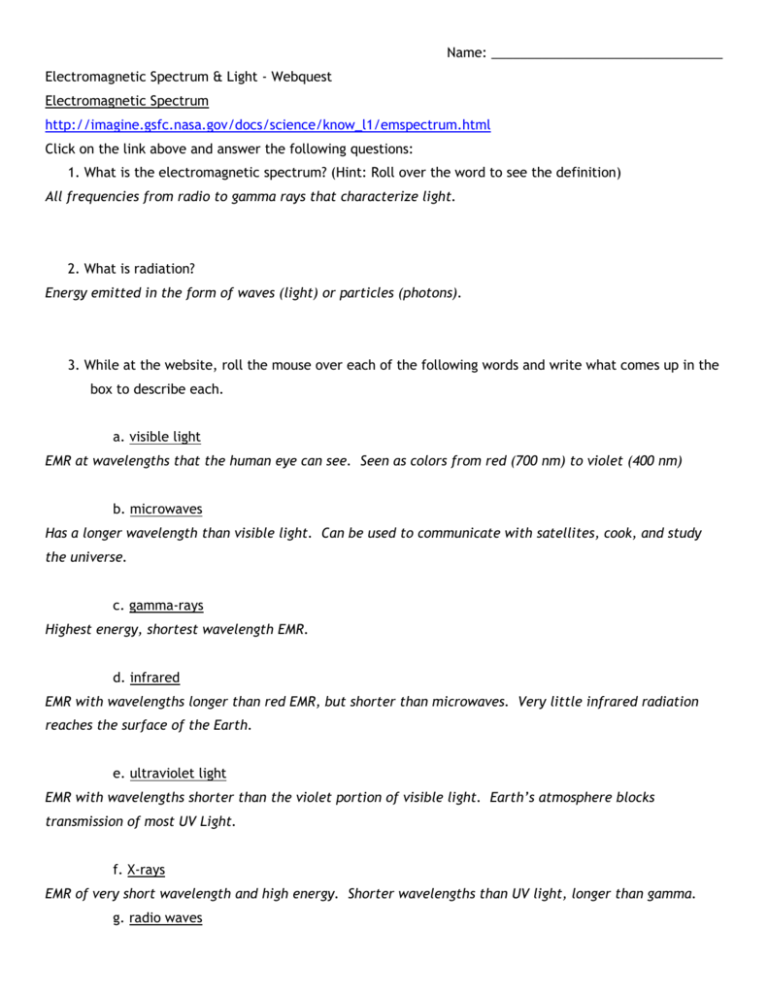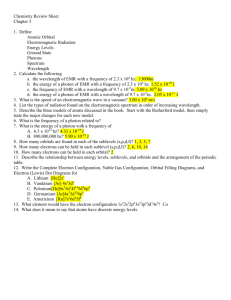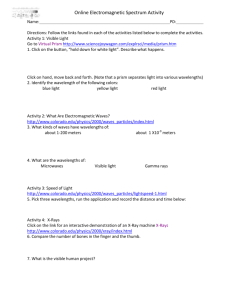Name: Electromagnetic Spectrum & Light
advertisement

Name: ________________________________ Electromagnetic Spectrum & Light - Webquest Electromagnetic Spectrum http://imagine.gsfc.nasa.gov/docs/science/know_l1/emspectrum.html Click on the link above and answer the following questions: 1. What is the electromagnetic spectrum? (Hint: Roll over the word to see the definition) All frequencies from radio to gamma rays that characterize light. 2. What is radiation? Energy emitted in the form of waves (light) or particles (photons). 3. While at the website, roll the mouse over each of the following words and write what comes up in the box to describe each. a. visible light EMR at wavelengths that the human eye can see. Seen as colors from red (700 nm) to violet (400 nm) b. microwaves Has a longer wavelength than visible light. Can be used to communicate with satellites, cook, and study the universe. c. gamma-rays Highest energy, shortest wavelength EMR. d. infrared EMR with wavelengths longer than red EMR, but shorter than microwaves. Very little infrared radiation reaches the surface of the Earth. e. ultraviolet light EMR with wavelengths shorter than the violet portion of visible light. Earth’s atmosphere blocks transmission of most UV Light. f. X-rays EMR of very short wavelength and high energy. Shorter wavelengths than UV light, longer than gamma. g. radio waves Highest energy and shortest wavelength of EMR. 4. What is the order of the electromagnetic spectrum from highest to lowest energy? Gamma, X-rays, UV, Visible, Infrared, Microwaves, Radio Waves Use the visual below to answer question 5. (a) Longer wavelength; (b) shorter wavelength 5. Which has more energy, A or B? Explain your reasoning. B. There is an inverse relationship between wavelength and energy. The larger the wavelength the lower the energy. 6. Define a wavelength. The distance between adjacent peaks or troughs in a series of periodic waves. 7. What is a frequency of a wavelength? Tells how many wave patterns or cycles pass by in a given period of time. Visible Light http://science.hq.nasa.gov/kids/imagers/ems/visible.html Click on the link above and answer the following questions. 8. What makes each color of visible light different? Each color of visible light has a different wavelength. 9. What makes up white light? White light is made up of a combination of all wavelengths of visible light. 10. For visible light (ROYGBIV), which has the shortest wavelength? Which has the longest? Place all the other colors in order based on their wavelength. Shortest- Violet Longest- Red From Longest to Shortest: Red, Orange, Yellow, Green, Blue, Indigo, Violet 11. What determines the color of an object we see? What happens to all other colors? The color of an object that we see is the color that reflects off of the object. All other colors of visible light are absorbed. Electromagnetic Spectrum http://www.lbl.gov/MicroWorlds/ALSTool/EMSpec/EMSpec2.html Click on the link above to answer the following questions: 12. What kind of electromagnetic radiation has the shortest wavelength? The longest? Shortest- gamma. Longest- Radio 13. What kind of electromagnetic radiation could be used to “see” molecules? A cold virus? Light used to see an object must have the same wavelength or smaller wavelength than that object. Molecules- xrays Cold virus- UV 14. Why can’t you use visible light to “see” molecules? The wavelength of visible light is too long. You need to use a wavelength of light that is the same size or smaller than the object that you are trying to see. 15. Some insects, like bees can see light of shorter wavelengths than humans can see. What kind of radiation do you think a bee sees? Bees can see light into the UV range. Behavior of Light http://camillasenior.homestead.com/optics3.html Click on the link above and answer the following questions. 16. What is reflection? Reflection occurs when an incoming ray (known as the incident ray) hits a surface. The incident ray hits the surface and then bounces off (reflected ray). The way the light is reflected depends on the surface that it hits. 17. Draw a picture of an angle of incident equaling an angle of reflection. Do on a sheet of loose leaf and staple to this activity after printing. 18. Explain the difference in how light will act on a smooth versus rough surface. On a smooth surface the angle of the incident ray and the normal surface will be the same as the angle of the reflected ray and the normal surface. On a rough surface, the rays of light will be reflected in many directions. 19. Define refraction. Refraction occurs when a light wave travels through different mediums. As it goes through different mediums it will change speed. The direction of the light also normally changes, and the light bends. 20. Explain what is happening to the spoon in the cup. Explain what is happening to the water in the pot. Light slows down and bends when it hits the water in the cup. The spoon appears different due to the bending of the light. When light hits the water in the pot it slows down and bends. Click the “Next” Arrow at the bottom of the page. 21. What is the difference between convex and concave lenses? Convex lenses are thicker in the middle then the edges and concave are thicker at the edges then the middle. When light travels through lenses, refraction occurs. The light bends either outward or inward, it depends on the lens. 22. On a sheet of loose leaf draw a picture of a convex lens and show how light hits it. Draw a picture of a concave lens and show how light hits it. 23. Is the lens of your eyeball a convex or a concave lens? Is a double convex lens.







